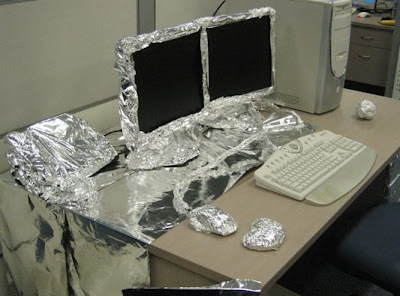
Have you visited some sites you’d rather others didn’t know about? Is your tin foil hat fitting a little tight? Well you’re about to get a little more paranoid or at least a little more educated.
You may have used some sort of software to “erase your tracks” after doing some web surfing, but the traces are always there. As my wife is fond of saying, “no matter where you go, you leave a footprint.” She’s a Zen master or something.
So where do the tracks get left? Cookies and temp files are obvious and you can take care of them with software like CCleaner. You may also want to use secure file deletion programs to completely remove deleted files from your hard drive such as Eraser.
But what about the stuff you might not know about yet? Here’s a couple of areas that may retain information you don’t want others to see, and freeware to help you deal with them.
Index.dat files
This works like a database. It’s not easily read by the human eye but contains the tracks of what programs you used, sites you visited, and even occasionally passwords. It resides in various places on your Windows computer, and stores information such as your computer usage history, cookies, and browser cache. You can check and clear it with Index.dat Suite.
With the Index.dat Suite you can:
- Make any index.dat file readable, right from within the Index.dat Suite program. Here’s a screenshot of what the Cache Index.dat file says about my recent visit to Microsoft. I can tell you that in an investigation into a user’s inappropriate use of a business computer, I came across a cookie that had the username and password to a major adult dating site in plain English, using Index.dat Suite. Good thing I’m an ethical administrator.
- Look through the Cookies and History index.dat files to see what sites were visited and when.
- Search for index.dat files anywhere on your computer, open them, and read them.
- Filter the type of files shown from the index.dat file.
- Select records and delete them, which is probably the most important part of this software that this article relates to.
You may be asking now, “Guy, why don’t I just open up the index.dat file, delete everything and then save the file again?”
I would answer that you could do that, but if you are truly a tin-hatter, you would know that a completely blank index.dat file is VERY suspicious to the black-ops type searching your computer. Or your administrator. Same difference.
Windows Registry
In the Windows Registry (a scary place to be) there are many MRU keys. MRU stands for “Most Recently Used”. Take a look at the screen shot below and you can tell exactly when, and what image I worked on in Photoshop. There can be literally thousands of records like these in your registry.
MRU Blaster can help you find these records and remove them. (Always back up your registry before altering it – if you don’t know how to do that, don’t mess with the registry.)
MRU Blaster can be set up to automatically clean out MRU registry keys every time you log off or on, or you can run it manually. I prefer to use it manually, because the MRU keys provide the information for the auto-complete feature in a lot of programs. MRU Blaster’s settings window allows you to choose which common MRU keys to check or ignore. This will help you preserve a lot the auto-complete information you may like to keep.
Here’s what a typical scan shows on my computer – 100 MRU lists with 1041 MRU Items. That’s a lot of information about my computer using habits.
The detailed results don’t tell me a lot about what the MRU keys contain. However, just knowing that there are 1141 footprints on my computer tells me it needs to be cleaned. You can select individual keys to clean or leave them all checked for a thorough cleaning.
Now you are like a ninja dancing on rice paper. No footprints!! Well, at least none that a non-ninja could find.
No comments:
Post a Comment